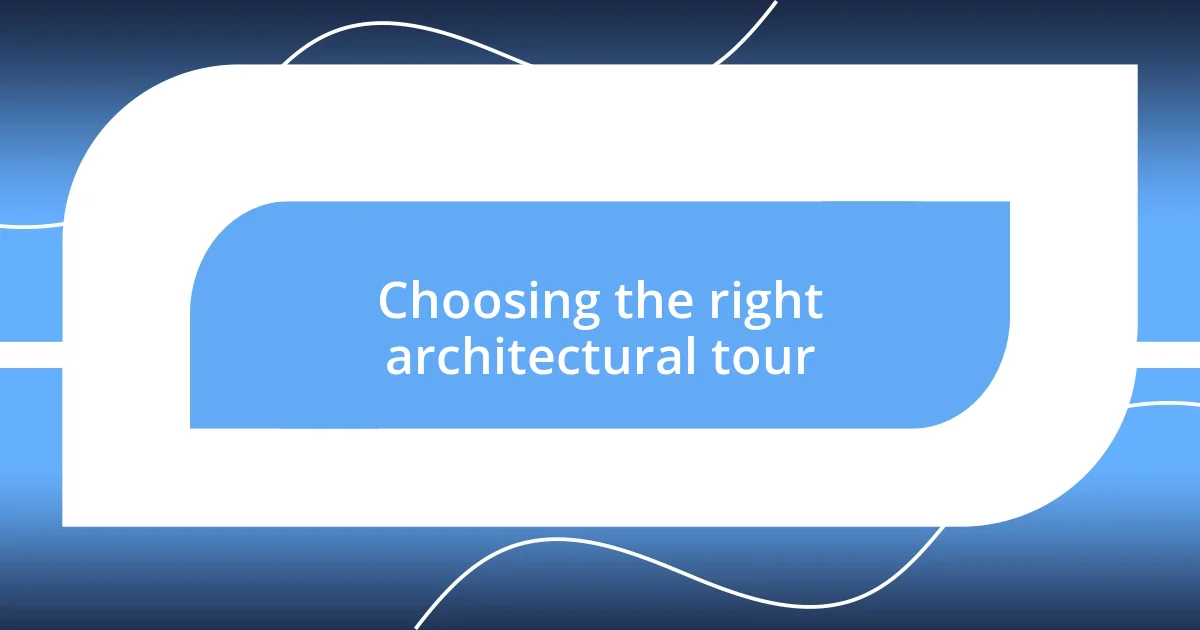Key takeaways:
- European architectural tours provide deep cultural insights, connecting travelers with the histories and stories behind iconic structures.
- Choosing the right tour depends on personal interests, group size, and the desired balance between structured learning and exploration.
- Notable destinations, such as Barcelona and Prague, showcase unique architectural styles that reflect the cultural identity and narratives of their cities.

Introduction to European architectural tours
European architectural tours offer a unique glimpse into the continent’s diverse cultural heritage. I remember walking through the winding streets of Florence, overwhelmed by the beauty of the Duomo’s intricate façade. How often do we pause to contemplate the stories behind the structures we admire?
Every city has its own architectural narrative, from the grand Gothic cathedrals of France to the minimalist designs sprouting in Scandinavian capitals. I once stood in front of the Parthenon, feeling the weight of history and inspiration in that moment. Isn’t it fascinating how each design reflects the values and aspirations of the people who built them?
Engaging with architecture on a tour can deepen our understanding of history and art, breathing life into what might otherwise be just another sightseeing experience. I often find myself pondering how much we can learn from the past through these remarkable structures—what do they reveal about our human journey?

Choosing the right architectural tour
Choosing the right architectural tour can be an overwhelming experience, given the myriad options available in Europe. I recall my excitement as I stood in front of the menu of architectural tours in Barcelona, where each tour promised a different exploration. The key is to reflect on what resonates with your personal interests—be it historical significance, modern design, or even eco-friendly architecture. What do you want to take away from the experience?
I’ve learned that the best tours often allow for a balance of structured learning and leisurely exploration. For example, during a guided tour in Prague, I appreciated how my guide wove personal narratives around the buildings, making the history feel immediate and intimate. It’s not just about seeing the architecture; it’s about understanding the context in which it was created. Is it essential to you to engage deeply with the stories of the past or to simply appreciate the aesthetics?
Another factor to consider is the size of the tour group. I once joined a large group in Rome, and while I loved the energy, I found it challenging to ask questions. Conversely, a smaller group tour in Amsterdam facilitated meaningful conversations that enhanced my experience. So, do you prefer the bustling vibrancy of larger tours or the personal touch of a more intimate setting?
| Tour Features | Large Group Tours | Small Group Tours |
|---|---|---|
| Cost | Generally lower | Usually higher due to personalized service |
| Flexibility | Less flexible with schedule | More options for customization |
| Engagement Level | More difficult for personal interaction | More opportunities for questions |
| Learning Experience | Broader but less in-depth | Deeper, guided insights |

Destinations with notable architecture
Exploring destinations with notable architecture is an adventure that often leaves a lasting impression on me. On a chilly morning in Brussels, I was mesmerized by the intricate details of the Grand Place. Standing amidst the elegant guildhalls, I felt as if I had stepped into a living painting. Each structure whispered stories of wealth and craftsmanship from centuries past.
Here are some must-visit destinations that truly showcase stunning architecture:
- Barcelona, Spain: The whimsical designs of Antoni Gaudí, especially the Sagrada Família, left me in awe. The melding of nature and architecture creates a surreal experience.
- Florence, Italy: The Florence Cathedral, or Duomo, with its iconic dome designed by Brunelleschi, is a marvel of Renaissance architecture that never fails to inspire.
- Paris, France: I was moved by the Gothic grandeur of Notre-Dame Cathedral, even more so after hearing about its history and restoration efforts following the fire.
- Prague, Czech Republic: Walking through the Old Town, with the breathtaking Astronomical Clock and stunning Gothic churches, made me appreciate how architecture can frame a city’s identity.
- Amsterdam, Netherlands: The unique gabled houses along the canals paint a story of trade and prosperity, capturing my imagination of the city’s Golden Age.
Every destination reveals a new narrative, and each structure acts as a portal into the cultural tapestry of Europe. It’s these emotional connections that enrich my travel experiences.

Unique architectural styles explored
When I think about unique architectural styles, a few moments stand out vividly in my memory. In Seville, the stunning blend of Moorish and Gothic influences in the Alcázar took my breath away. I found myself wandering through the lush gardens and intricate tilework, genuinely feeling the layers of history embedded in every corner. Have you ever stood in a place where you could almost hear the whispers of the past? It’s a feeling that stays with you long after the visit.
One particular tour in Lisbon introduced me to the Manueline style, a Portuguese take on late Gothic architecture characterized by intricate maritime motifs. As I marveled at the Jerónimos Monastery, I couldn’t help but be engulfed by the grandeur and complexity of its design. It captured my imagination how each stone seemed to tell tales of explorers setting sail for new worlds. Is it possible for architecture to tell a story that resonates within us? Absolutely, as I felt an indescribable connection to those distant voyages.
Exploring the modernist designs of cities like Helsinki opened my eyes to the striking functionality and simplicity inherent in Scandinavian architecture. The structures felt almost like a reflection of their surroundings—clear, open, and in harmony with nature. When I visited the Finlandia Hall, I was struck by how the building seemed to breathe with its environment, inviting visitors to pause and appreciate art, music, and the beauty of design. Can architecture be a catalyst for creativity and connection? In this case, I’d argue it was. Each unique style I’ve encountered has enriched my understanding of not just architecture, but of culture itself.

Cultural insights during tours
During my architectural tours, I often find myself immersed not just in the structures, but in the rich cultural narratives they embody. For instance, while strolling through the streets of Vienna, I discovered how the city’s grand architecture reflects its historical significance as a cultural hub. It was fascinating to learn about the influence of the Habsburg monarchy and how it shaped the artistic landscape of the city. Have you ever truly appreciated how a building can encapsulate a nation’s pride and identity? In Vienna, this realization was vivid and transformative for me.
On another trip, as I stood before the stunning palaces of Berlin, I was struck by the juxtaposition of old and new architecture, each telling a story of resilience and rebirth. The Reichstag, with its glass dome, symbolizes transparency in governance—a stark contrast to its historical past. Listening to a guide share the tales of World War II and the reunification of Germany left me pondering how architecture can serve as a powerful reminder of a nation’s journey. Don’t you think it’s incredible that these structures are witnesses to both triumphs and trials?
I’ve also gained insights into local customs through architecture during my visit to Istanbul. Visiting the Hagia Sophia, I marveled at how it has switched roles throughout history—from a church to a mosque, and now a museum. This melding of cultural influences was palpable in the architecture, revealing layers of tradition and belief. I felt a deep connection to the spiritual stories woven into the very walls of this magnificent structure. It’s moments like these that prompt reflection: can a building shape our understanding of faith and community? For me, the answer is a resounding yes.

Personal reflections and highlights
One highlight that lingers in my memory is my visit to the Sagrada Família in Barcelona. As I stood beneath the soaring columns that resemble trees in a forest, I felt an overwhelming sense of awe and tranquility. The intricate details and vibrant colors among the stained glass windows seemed to paint emotions I couldn’t quite articulate. Have you ever experienced a place that left you speechless yet full of wonder? That was my moment there, a beautiful reminder of how art can transcend the ordinary.
I vividly recall wandering through the winding streets of Prague, where the Fairytale-like architecture spoke volumes about the city’s rich history. Each structure unveiled a story, yet it was the intricate carvings on the facades of the medieval buildings that truly captivated me. As I traced my fingers over the intricate designs, I felt a connection to the artisans who had poured their souls into their craft centuries ago. Isn’t it fascinating how, through architecture, we can connect with people from the past in such a tangible way?
One evening, as I stood near the Colosseum in Rome, with the warm glow of the setting sun casting long shadows, I reflected on the trials and tribulations that this ancient structure has witnessed. Imagining the gladiatorial battles that once took place, I felt a mix of admiration and sorrow. The grandeur of the Colosseum is matched only by its layers of stories that resonate deeply with the human experience. Have you ever felt the weight of history in such a profound way? For me, standing there was a moment of humility, realizing that architecture not only tells stories but holds the very essence of humanity within its walls.














